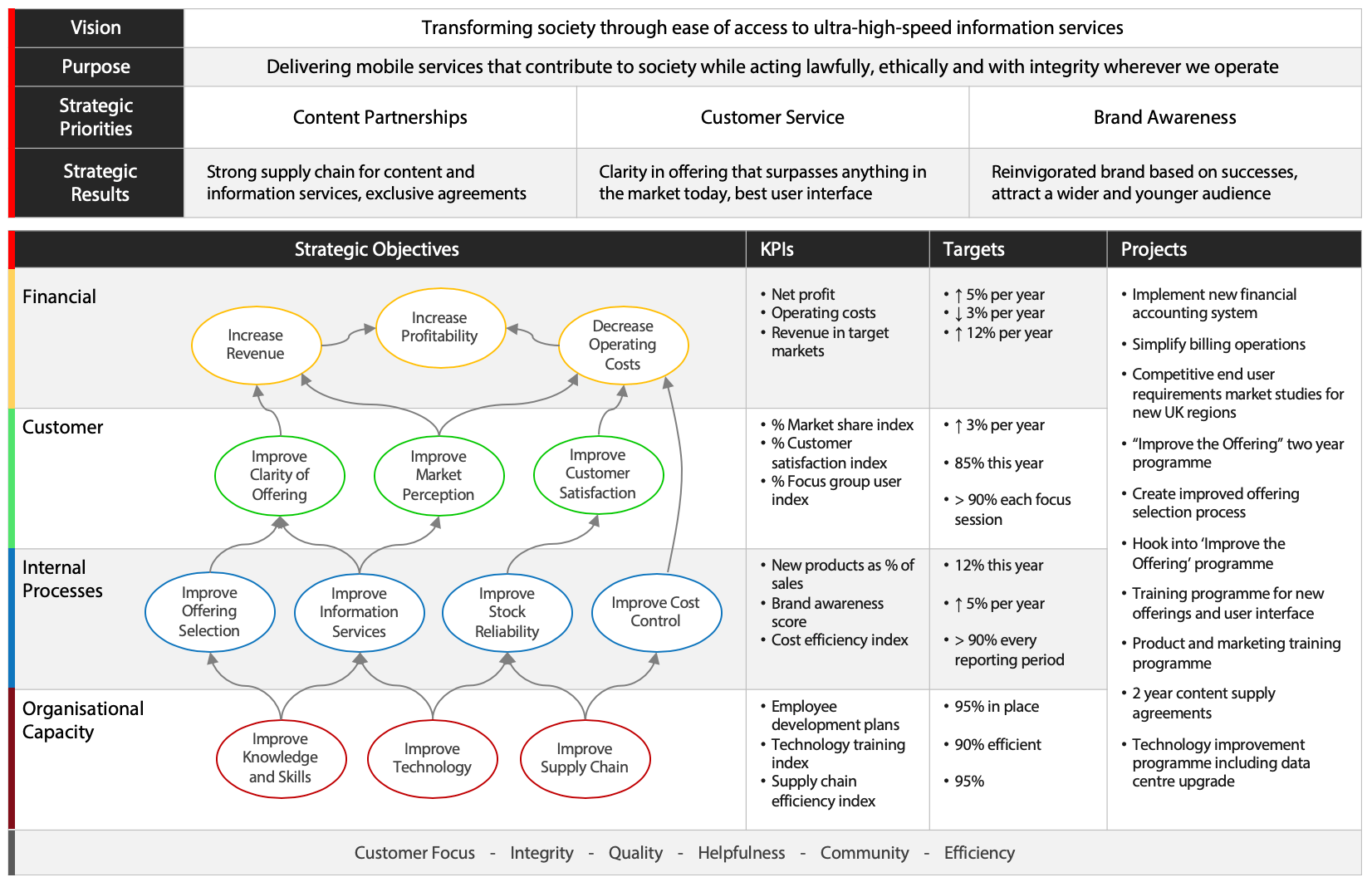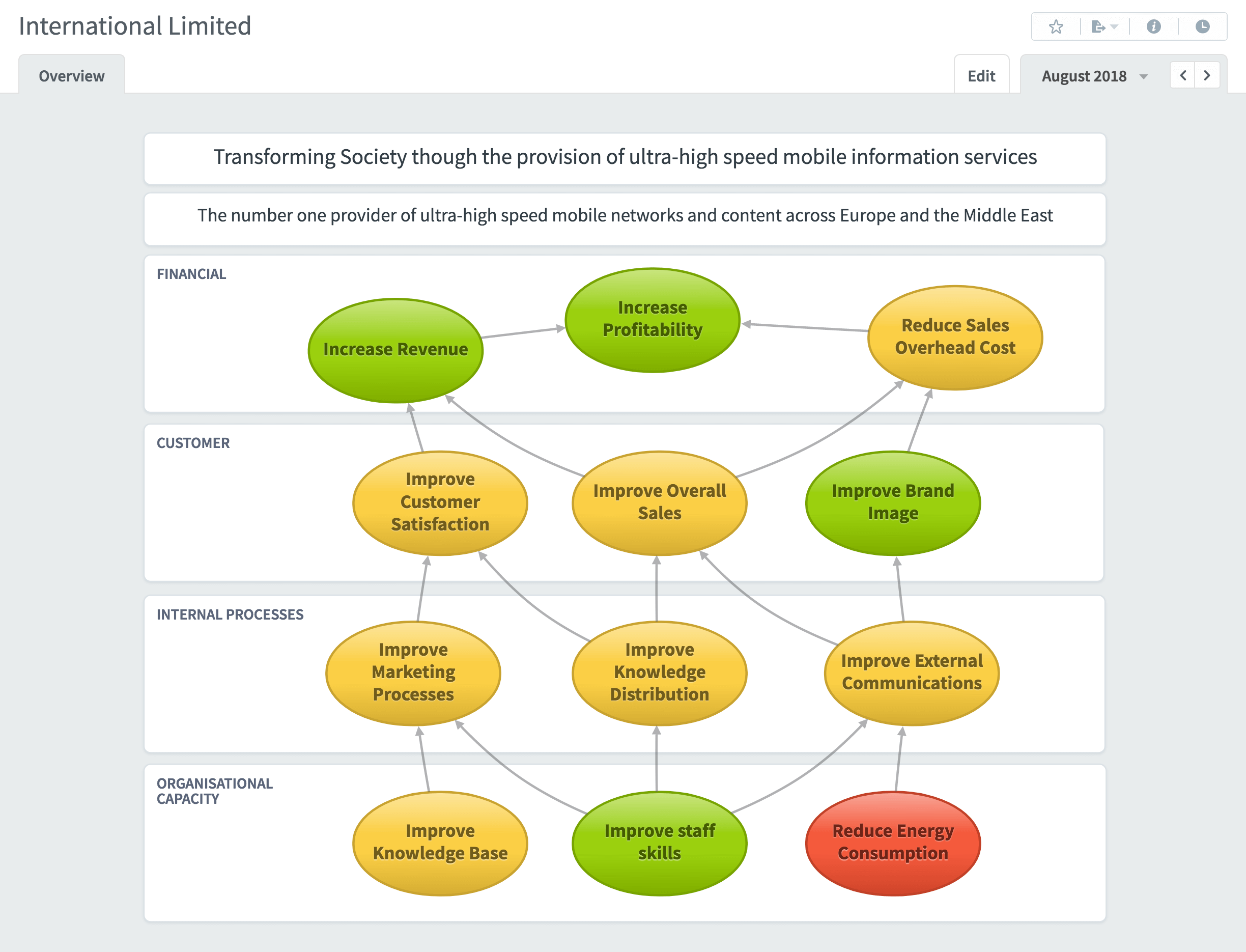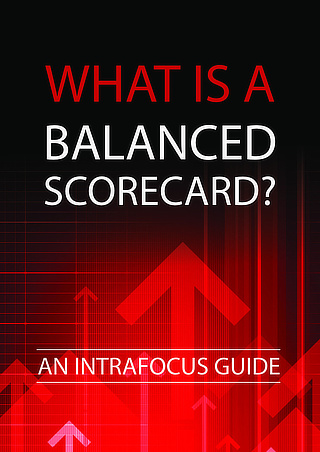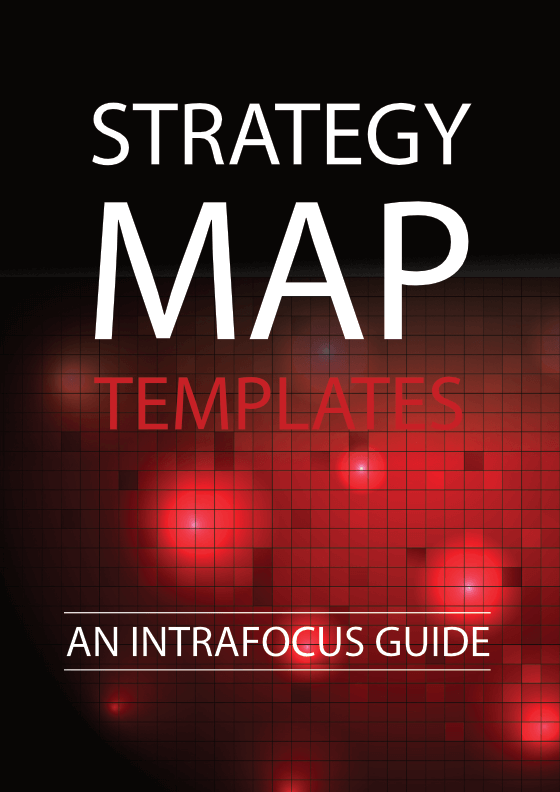Dr Robert Kaplan and Dr David Norton published the paper in 1992 and formally as a book in 1996. Both the paper and the book led to its widespread success. Interestingly, although Kaplan and Norton published the first paper, Art Schneiderman referenced the article sometime previously and is believed to be the balanced scorecard creator.
The Basics
So it’s more than just financial measures?
Correct! Kaplan and Norton introduced a balance across all organisational functions. The problem was that most companies focused on financial measures, for example, revenue growth and profitability. Looking at an organisation across four Perspectives, a causal relationship between investment, operations and a financial outcome can be defined, measured and managed.
Okay, it’s a scorecard.
The BSC is not just a scorecard. It is a methodology. It starts by identifying several financial and non-financial objectives related to strategic priorities. It then looks at measures, setting targets and strategic projects (often called initiatives). In this latter stage, the approach differs from other strategic methodologies. It forces an organisation to think about how objectives can be measured and only then identifies projects to drive the goals. Leaving the identification of projects to the end avoids creating costly projects that may not impact the strategy.
Focusing on four areas of financial and non-financial objectives brings about the balance. These are the Perspectives. They are Financial, Customer, Internal Processes and Organisational Capacity
The Four Perspectives
Questions often arise about the four Perspectives described in the methodology. Why should we only look at Financial, Customer, Business Process and Organisational Capacity? Why not include Health and Safety? The answer is, of course, nothing is stopping us. The four perspectives are simply a framework. However, over decades of use, it has become clear that they work.
More importantly, there is a causal relationship between the perspectives. Working from the bottom to the top: Changes in Organisational Capacity will drive changes in Business Processes. These, in turn, will impact Customers and improve Financial results. The causal relationship may not be guaranteed if a new perspective is added. The result might be a helpful scorecard, but it would not, by definition, be a balanced scorecard.
In brief, the four scorecard perspectives are:
Financial
The organisation’s high-level financial objectives and financial measures help answer the question – How do we look to our shareholders? Financial objectives are usually the easiest to define and measure. However, creating a financial objective, for example, Improve Profit, rarely provides a clue as to how to achieve the objective. By linking objectives from the lower levels in the model, we see exactly where to define projects and make investments.
Customer
In the Customer layer, we find objectives and measures directly related to the organisation’s customers, focusing on customer satisfaction. They answer the question: How do our customers see us? It is essential to take a step outside and view the company or organisation from the customer’s viewpoint. We need to understand what they want from us, not necessarily, what we can do for them.
Internal Processes
In the Internal Processes layer, we find objectives and measures that determine how well the business is running and whether the products or services conform to what is required. By streamlining internal processes, an organisation can reduce some of its most significant cost items. Processes are also an excellent area to focus on new and creative ideas.
Organisational Capacity
In the organisational layer, we find objectives and measures concerning how well our people perform, their skills, company culture, and leadership. This area also includes infrastructure and technology. Organisational Capacity is the area where most investment takes place. It answers the question: How can we improve and create value?
The real value of the Perspective approach is that it provides a framework to describe a business strategy. It focuses on objectives and measures that inform us about progress and allow us to influence activities to achieve our strategy.
Strategy Map
The framework is often presented as a Strategy Map, as shown below.
The four scorecard perspectives are in a specific order and contain strategic objectives contributing to a Vision and Mission. The Strategy Map provides a powerful tool allowing the user to talk about the causal impact of investment at the bottom, leading to improved financial results at the top.
A software tool created the diagram above. Software is not required, but it helps. Furthermore, good software tools will allow a user to ‘drill down’ to the underlying data should the need arise to question a specific activity, objective or performance measure.
Strategic Objectives
Strategic objectives turn a passive strategy into an active one. An active strategy motivates and drives people to do their best. It is not an additional or separate activity bolted on the side or something to be done when time allows. In his book, The Institute Way, Howard Rolm describes the balanced scorecard system. It sums up Strategic Objectives by saying: “Strategic Objectives are considered the DNA of the BSC system” Rolm recognises that in any strategic planning process, the way to bring a strategy alive is to create meaningful Strategic Objectives.
Don’t be fooled
Don’t be fooled into thinking strategic objectives are just part of corporate executive slideware. Strategic objectives apply to all levels of an organisation. The statements used may differ, but their impact will be the same. A corporate strategic objective may be more encompassing, for example, to Improve Customer Satisfaction. A business unit or department level may be more specific, for example, ‘Improve customer satisfaction through better customer contact’. And finally, at an individual level, the strategic objective may be more specific still, for example, ‘Improve customer satisfaction by spending at least 40% time on the customer site’.
There is an interesting observation concerning this personal objective described above. An assumption has been made that spending 40% of their time on a customer site is desirable. That is, it will improve customer satisfaction. The relationship between improved customer satisfaction and spending time on a customer site has been considered valid. Creating performance measures is not simple, especially when there are complex cause-and-effect relationships. For more information on this subject, see our white paper ‘Developing Meaningful Key Performance Indicators’.
One of the most common pitfalls
One of the most common pitfalls seen when creating Strategic Objectives is to describe projects rather than objectives. For example, it may be a strategic imperative to “Create a new CRM system and roll it out”. However, it is not a Strategic Objective. The Strategic Objective that might include this project could be “Improve customer service through tools and technology”. It is not a case of semantics, either! “Create a new CRM system and roll it out” is a project that will end; it is not a continuous improvement objective. The only way to measure it is to check that milestones have been achieved and the project has been completed. There is nothing about the project that demonstrates a performance improvement.
The outcome is important, not the project
It is the outcome of an activity that demonstrates a performance improvement. Projects and initiatives have a place in performance improvement. They drive strategic change. However, it is vital to ensure we are not doing projects for projects sake. The reason for the project must be apparent, and the ‘outcomes of the project must be measurable. In this way, they can relate to strategic objectives. Strategic objectives are the building blocks of a good strategy. They give clear guidance to the organisation as to what is essential. Through description and cascade, they provide the means to ensure everyone is involved and aligned.
Key Performance Indicators (KPIs)
Once created, input to a Scorecard comes in the form of Performance Measures, often referred to as Key Performance Indicators (KPIs). A KPI provides information an organisation requires to determine whether it is performing well. Unfortunately, in some organisations, KPIs are often indistinguishable from operational measures. Organisations frequently take the view that everything should be measured and reported. A KPI is a Key performance indicator. It is one of a few measures designed to reduce the complex nature of organisational performance and turn it into something that can be understood easily and acted upon quickly.
Measure the ‘health’ of the organisation.
Much like a doctor or nurse will monitor pulse rate and temperature to determine an individual’s overall health, managers can monitor KPIs to assess the health of an organisation. Where to start depends entirely on the strategy an organisation is deploying. There must be a direct relationship between what an organisation is trying to achieve (the strategic objectives) and what is being measured to determine progress towards the objective. There will be a lot of operational measures, and some of these may contribute data to the Key Performance Indicators. Operational measures should be considered as ‘housekeeping’ and ‘good practice’ and should not be confused with KPIs. The approach gives us the framework to take a ‘balanced’ view across an organisation and define strategic objectives in the four perspective areas together with the associated KPIs. We must be careful to define only a few strategic objectives.
Focus, focus, focus
It is better to focus on a small number of things rather than to spread the workload so thinly that nothing is achieved. Business strategy consultants Franklin Covey put it very well:
- If your strategy has 3 objectives, you will succeed in all 3.
- If it has 4-10 objectives, you will succeed in 1-2.
- If it contains more than 10 objectives, you will succeed in none.
It is a simple case of the law of diminishing returns. Finally, KPIs must contain both leading and lagging measures. Most strategic plans concentrate on lagging measures. Why? Because they are easy to measure and they are accurate. If I want to lose weight, I get on the scales. This gives me proof positive if I have succeeded or not. It does not give me any help to succeed. If I measure how many times I go for a run and how much I have eaten (and plan for this), I have put two leading measures in place to help me succeed. Leading measures are harder to identify, but they are the only ones that can be influenced and make a difference. We must recognize the importance of leading measures when creating a Scorecard, defining our strategic objectives and choosing our Key Performance Indicators.
Who uses it?
Companies, organisations and governments across the world successfully use the BSC. It is a business-performance management and performance measurement system combined. Organisation size is not a consideration. Although the BSC is used by over 50% of the world’s largest companies, it is also used by countless small to medium-sized companies. The only restriction applicable to the BSC is that the organisation has to be established and in place for several years. The BSC does not work well for start-up companies. Some well-known organisations that use the balanced scorecard include Thompson Reuters, Volkswagon, Philips Electronics, UPS and the FBI.
BSC Approach
Organisations often begin the scorecard process by reading one of the many books on the topic, attending a seminar, or doing web research. There are many resources for elementary education and training. Once an organisation has committed to the balanced scorecard model, a third-party facilitator can be brought in to manage a strategy workshop and bring an unbiased view to the scorecard development process. Scorecard development can be remarkably rapid (a few weeks) or as long as a year, depending on the scope and complexity of the scorecard and organisation.
Many organisations elect to go with a rapid or intermediate approach, which ensures project momentum and recognises that score-carding is an iterative process. It is often better to make and correct mistakes early while an organisation is still excited about the methodology. Initial scorecard work is typically done with Microsoft Excel, PowerPoint, or Word. As the scorecard matures, the methodology is rolled out to the rest of the organisation. The goal is to connect all employees to the organisation’s strategic objectives using individual or group measures. A software tool will be required to do this efficiently.
Sustaining the Scorecard
The premise of the methodology is to provide an ongoing, living framework that management can communicate to the whole organisation. The scorecard needs to be sustainable and easy to roll out. Scorecards should leverage technology to provide automation as far as possible. Ultimately, the scorecard should become part of the organisation’s culture and employees’ work experience. An easy-to-deploy web-based system will allow for rapid roll-out and a sustainable scorecard.
Culture and Connection
Once the team has developed a scorecard, it is essential to cascade it into the organisation. The balanced scorecard and associated strategy will help align departments, teams and individuals. Everyone must understand the cause-and-effect relationship and how it connects to the organisation’s overall performance. The goal is to translate the strategy into the staff’s “everyday language” and identify measures of success that link to the overall strategic direction.
Using a Software Solution
Using a software product will allow everyone in the organisation to understand cause-and-effect relationships clearly. They can then execute the strategy, align with the organisation, and provide measurement and a continuous feedback mechanism. Look for the following key features when selecting software:
Web Based
Look for a solution where development and deployment are through a web browser. Cross-browser compatibility is essential. Solutions using the latest developments in web technology are always preferable.
Ease of Use
Select a solution that is extremely easy to use. Choose a product that functions as far as possible, like desktop software. Look for products where data can be entered through the web interface, uploaded from a CSV file, or automated with a database connection. Products should be as easy to use as browsing a web page or shopping online.
Strategy Maps
The key to a good design is the strategy map. Any product selected should be able to create strategy maps with drill-down capabilities. Strategy maps often start as a blank canvas to which you add images, shapes, gauges, graphs, text, and numbers to represent your data visually. Once you make a strategy map, however, the colours and numbers should automatically update based on the actual data in your system. You can use Strategy maps to track key metrics, visualise geographic data, and monitor trends.
Cascaded Scorecards
An organisation-wide roll-out requires multiple cascaded scorecards. The organisation should start at the top and roll down into a department, group, or employee level. Look for products that allow for unlimited cascaded scorecards. Organisations should be able to drill through to sub-scorecards or individual measure views. The entire organisation should be able to roll up information from multiple scorecards into higher-level scorecards.
Communication
Look for products that allow for commentary on each level of the scorecard. It should be possible to create comments that are either general or period specific. Alerts, such as when your metric needs updating or when it turns Red are essential communication components.
Alignment
A good solution will allow you to create aligned objectives so that scorecards can show the performance of their objectives and measures or supporting objectives across various scorecards.
Automated Scoring and Weighting
A scorecard tool should allow for automated scoring and weighting of structure elements. You should be able to build your structure, define the weighting, enter the measure values, and watch the scorecard “colour-up.”
Initiative Management
Many initiatives will come out of the process. Look for products that have sound initiative management modules to manage these scorecard initiatives. Creating tasks and milestones should be possible, and assigning them to individuals or groups.
Report Writing
Getting the correct information to the right people at the right time is vitally important. A good solution will come with a built-in report writer that contains canned reports like Red Metrics Report, Grey Metrics Report (missing values), and Metric Comparison Report (compares metrics within and across scorecards). The tools should also allow the user to pull data from a scorecard database for ad-hoc reporting.
Integration to Desktop Tools
The solution should allow users to export graphs, reports, and scorecards to desktop applications like Adobe Acrobat, Microsoft Word, Excel, and PowerPoint.
Briefings
The tool should be able to create online briefings to consolidate data for management, groups, or users. Briefings should be easy to set up by browsing the model and adding views, reports, and graphs. Once the briefing is created, it should be easily viewed online or allow for export to Adobe Acrobat, Microsoft PowerPoint, Word, or Excel.
Key Benefits
After decades since its introduction, this methodology is now accepted by many organisations as the de-facto method to gather information, make decisions and implement a strategy. It has been estimated more than 50% of medium to large organisations use the approach for business performance management. The key benefits are:
Improved organisational alignment and communication
The approach necessitates that the whole organisation adopts the method from department to division to enterprise. It becomes a single standard for all. The immediate benefit is a common language, a common set of strategic objectives, and a metric structure. This does not mean that the Balanced Scorecard must be implemented across an entire organisation immediately. Indeed, the best approach is to start small (usually at the executive level) and roll out over a defined period.
Better strategic planning
Creating a Strategy Map forces an executive team to think hard about the relationship between a strategic objective, initiatives and the metrics required to help with the success (leading measures) and determine actual success (trailing measures). The strategy map, therefore, becomes the cornerstone of strategic planning. It has the added benefit of being the communication medium of the strategy (and the way it will be measured) to the rest of the organisation.
Improved performance reporting overall
The mind is focused on those things that must be reported to the management and executive teams. Other things need to be measured and reported upon, but the simple fact that the management and executive teams are clear on what they need will cause the whole organisation to think about what is required and, more importantly, why. One of the obvious benefits of this activity is that unnecessary reporting will be eliminated. The Balanced Scorecard becomes an extremely powerful tool to ensure organisational alignment, improve communications, achieve much stronger strategic planning and ultimately lead to a better-performing organisation that is in tune with its business strategy.
Wikipedia has a good overall description, including the history of the Balanced Scorecard.
Watch the Video
Download a copy of the final drawing.
Read our guide: What is a Balanced Scorecard?
Download our Strategy Map Templates
The Integrated Balanced Scorecard
The example above is an example of an Integrated Balanced Scorecard. It includes all the elements of a strategy from Vision through to Initiatives. For more information on how to create an integrated strategy go to our Strategy Workshop pages.





